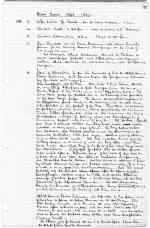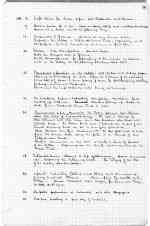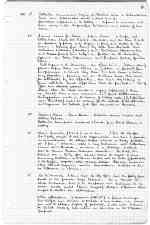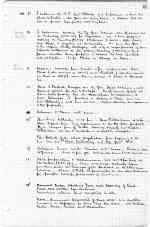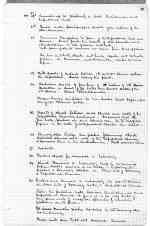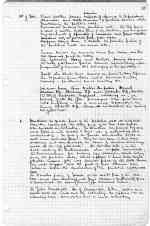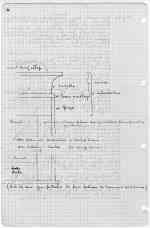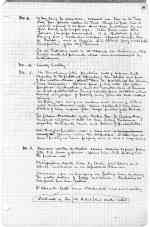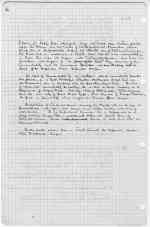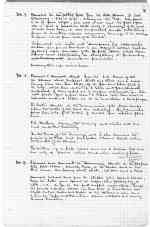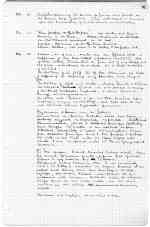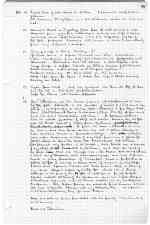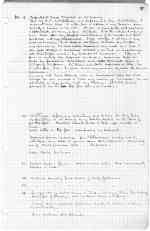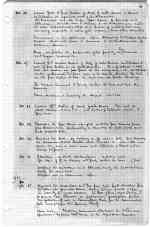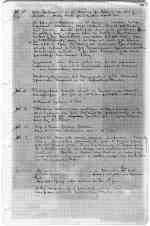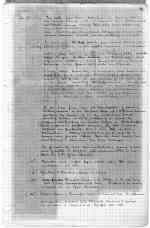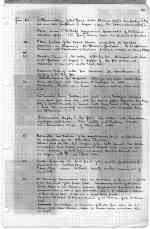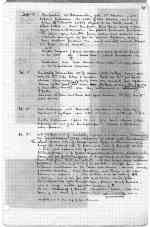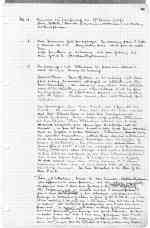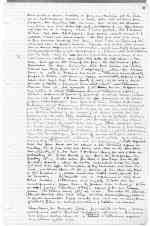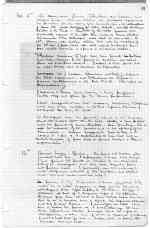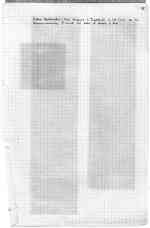Excavation journals and diaries made by Howard Carter and Arthur Mace
Howard Carter's excavation diaries (transcripts and scans)
2nd Season, October 3rd 1923 to February 9th 1924
This is Howard Carter's journal for the 2nd excavation season of the tomb of Tutankhamun which took place during the Winter of 1923-4. The events covered by this journal are the packing of the final object from the Antechamber (November 30th 1923), preparation for work in the Burial Chamber (December 1st 1923 onwards), and the moment when all the doors of the sepulchral shrines were opened allowing Carter and his team to view the quartzite sarcophagus of Tutankhamun for the first time (January 3rd 1924).
The journal is housed within its original black ring-binder, stamped "Walker's Loose-Leaf Book, Cover Number 138" on the inside front cover, it measures 33 by 21.5 by 1 cm. and contains 148 loose-leaf, graph-lined pages. TAA Archive i.2.1, pages 77 to 115. All entries are in Howard Carter's hand.
This transcript follows the format of the original document, and any insertions, deletions or duplications are indicated accordingly. Scans of the original journal pages are provided and are positioned to the right of the transcript, these are magnified by positioning the pointer on the image.
Left London for Trieste, per Simplon Express, 11 am.
Arrived Trieste 11.30 pm - went on board S.S. 'Helouan'.
Arrived Alexandria 4 pm. Cairo 10.30 pm.
Saw Quibell at the Cairo Museum with whom I made
plans for the coming season's campaign on the tomb of
Tut.ankh.Amen.
We discussed what measures should be taken to
avoid newspaper disputes and difficulties with regard to
visitors, which rendered the Tut.ankh.Amen work so difficult
last year.
Went to Alexandria to see the Minister of P.W.D., Abd El Hamid
Pasha Suleman and placed before the programme discussed
by Quibell and myself.
The proposals: (1) the Press. Now that I had taken Merton
on my staff I proposed to give through him the same
daily report to The Times and to the Egyptian Press. The
Times news would be cabled out in the evening to be printed
in the next day's paper. The same news would be given to
the Egyptian Press early in the morning, in ample time
to be printed in the papers of the day. Thus news would reach
the public in London and in Cairo practically at the same
time. I also pointed out that in this manner the Cairo
newspapers will get for nothing what all European and
American papers will have to pay for. (2) Visitors - I pointed
out that to admit visitors one day each week would
involve a very serious loss of time. The day before visitors
are received, all delicate objects must be removed or es-
pecially protected; tools put away, electric wiring altered,
and a clear path made. All this involves hours of work
the day before and hours of work the day after, and thus
each week one whole day and parts of two other days would
be sacrificed. I therefore proposed that no visitors should
enter until after a definite part of the work of this season
is done, and that after an official inspection or opening,
our scientific records taken, visitors should be allowed to enter
by tickets obtained through the Public Works Ministry, for a time,
a week or more, if this considered necessary. That this would
probably only be possible after the opening of the
sarcophagus as there would be little or no room to permit
passage of visitors before then - the shrines taken up the whole
of the area of this sepulchral chamber. The other chambers,
namely the Annexe and Store Chamber being permanently temporarily closed
until the moment for dealing with them came.
Abdel El Hamid Pasha Suleman was agreeable to this plan and
asked me to place it before Furness at the Residency - this
I did before lunch and Furness was also agreeable.
Furness after returned my note with his letter dated Oct 17th
wherein he remarks that he shewed it to Scott who remarked
that he feared the proposal about visitors would cause disappointment
to many tourists.
As I do not work for tourists nor am I a tourist agent I have taken
no notice of this futile remark.
Left Cairo for Luxor 8pm with Callender and Burton.
Arrived Luxor 9.15 am. Where our native staff met us and reported all well.
Remained in Luxor until the following day.
Crossed over to Goorna - arriving at my house 11am.
Inspected the Valley - Tut.ankh.Amen Tomb, Laboratory, and
Magazine - finding everything and men in good order.
Parker - Times correspondent - arrived Luxor.
Motor car brought over to Goorna.
Made arrangements for operations to commence on exterior
work in the Valley on the following Monday - Oct. 22nd.
Commenced operations in the valley: with 25 men and 50 boys began
clearing and levelling the area before the entrance of the laboratory
(tomb Seti II). So as to have plenty of room for photographing, restoration,
packing, and for the carpenters.
Parker and his wife visited the works during the morning.
The levelling before laboratory completed as well as path
leading up to same. Started Started filling up holes en
route from Tut.ankh.Amen tomb to Lab.
Commenced upon removing the debris placed last season
over the tomb of Tut.ankh.Amen .. The work in charge of
Reis Ahmed with ten men and Reis Hussein Abou Owad with
twenty boys- the debris being used to fill up the S. end of the
trench exposing huts on the S. end of the foot-hill.
Reises Hussein and Qus continued with the rest of the men to make
good the various holes along the path in the vicinity of the
Akh.en.Aten vault.
Burton commenced on the 22nd to make a series of photos
of the Valley - beginning at the mouth continuing towards the royal tombs.
Tut.ankh.Amen cleared to top of staircase. Mason commenced
upon repairing the retaining walls. The tidying of the rest
of the Valley also completed.
Opened laboratory (Seti II tomb No. 15) and commenced
sorting materials therein. Men paid for week ending
today - Reises received their wages, for summer duty,
to Oct. 31st 1923.
Completed preparations in Laboratory and also Magazine.
Put down matting in first bay of Laboratory.
Callender commenced laying the electric wires to Tut.ankh.Amen
tomb and Akhenaten vault (Dark-room).
Bradstreet appeared in the valley. Refused to converse with
him owing to his disgraceful behaviour and action of last
season.
I must leave for Cairo - 6 pm train - to confer with
Tottenham (Under Sec. P.W.D.), Quibell, and the Min. P.W.D.
on question of policy with regard to press and visitors for this
season. Having just heard by letter from Quibell that
Valentine Williams (Reuters) and Bradstreet (Morning Post
and Hearst press) had lodged a protest at the Ministry
against The Times agreement and proposed policy for this
season.
With regard to the Ministry, as aforesaid, I had already
placed before them in Cairo and Alex. A perfectly fair
programme to which they then did not seem to raise
any objection, pointing out at the same time there would
be attacks by the opposition, but that by taking a
firm attitude such opposition could be frustrated: the Eg.
Gov. had obviously waivered.
I trust when the whole matter is again explained to them
we shall come to an agreeable and final settlement.
The suggestions made in the memo of today's letter (by Tottenham
and Quibell) would be working for the interests of the opposition
and against the interests of the Gov. as well as ourselves.
Arrived Cairo. Saw Merton. Inscribed name visitors book
Abdine Palace.
Callender transported materials & timber from rail station to
Valley.
Went to Ministry (P.W.D.) 10.30 am. I found the Eg. Gov.
had fully armed itself with legal advice and that it persisted
in maintaining its alleged right to issue a daily bulletin
at 8 pm. However, after a long discussion with Tottenham,
Lacau and Quibell, we came to a decision to which
Abd El Hamid Pasha Suleman assented - in brief this
decision was: the Eg. Gov. should waive its rights to issue
summary bulletins, and should confide all the duties of publication
to the digger. to gather other minor details There were included
other details regarding visitors surveillance to which we had
no difference in opinion.
At the Ministry I found that the Eg. Gov. had completely gone
back on the previous day's decision. As a result the
whole discussion had to be reopened and continued in a
vicious circle until I found myself obliged to present what
might be called an ultimatum.
To this ultimatum I received (Nov. 8th) a phone message
that the Gov. had decided to accede to my wishes, i.e., invest
me with its alleged rights of publicity, in other words, I should
be the sole source of information as laid down in the original
proposal.
I called on the H.C. Lord Allenby and explained to him the
whole situation. He gave me every reason to believe that he
was in perfect sympathy with my case.
A document covering the Eg. Gov. decision was promised me
on Saturday (Nov. 10) for signature. As I had received
nothing on Sunday (Nov. 11). I returned to Luxor, after having
sent Merton to inquire at the Ministry. He found the Gov.
to be again shilly-shallying with only a vague promise of some
definite settlement on the following Tuesday (Nov. 13). So to
force matters I was prepared to recover the tomb and stop
work altogether. Left Merton in charge in Cairo.
Received message from Burton 5 pm informing me that
Mace (who arrived on Nov. 12) and Bethell (who had arrived
in Cairo on Nov. 7) were coming at once to Luxor to consult
me.
Mace & Bethell brought me the Gov. final decision, with
general advice for me to accept. In its main points it
was satisfactory but the reservations so weakened it
that I thought it prudent to return to Cairo and see
Lord Allenby, & ask his advice, before sending an agreement
to the proposals.
Returned to Cairo with Mace.
Saw Lord Allenby 11.30 am. Saw Tottenham 4.30 pm,
when I gave him my agreement to the Eg. Gov. proposals
in lawyer's form of letter covering myself and rights.
Tottenham led me to understand it would be accepted.
For details of the whole negotiations from beginning to the end see file "Press Controversy and Eg. Gov." No. 8
Returned Luxor with Merton and Mace. Crossed over
to Gurna. First copies of the Tut.ankh.Amen book arrived.
Made preparations to recommence work and open tomb on
the morrow (Nov. 19). 5 men & 15 boys actually began
and completed the removal of the rubbish in the staircase
entrance. Mace & self experimented on our new contrivances for paraffin wax for preservation of the objects.
Removed timber blocking from outer doorway of tomb.
Fixed new wooden door on same.
Examined interior found everything in order.
Mace commenced preservation of couch No. 35 - lion headed.
Lunched in magazine for first time this season, with Bethell,
Merton, Mace, Burton and Callender.
Connected up the electricity in both Antechamber and
Sepulchral-hall.
Burton made photographic records of the interior of the
Store Chamber.
Commenced draughting the plan of the Sepulchral-hall and
Shrine. Burton finished his records of Storechamber and
objects between N. side of shrine and wall.
Made plan of objects removed last season from front of shrine.
Sir Lee and Lady Stack and party together with the Mudir
of Kena, the Maamour, and Hakimdar, visited the tomb
3 pm.
Made records of contents between 1st and 2nd shrine within
the Sepulchre. Burton taking his photos.
Continued records of forepart of 1st interior of 1st shrine
as well as a record of the corded and sealed staples of the
2nd shrine. Closed Storechamber.
Mace having completed the lion-headed couch began upon
one of the chariot bodies.
Records of objects between outer shrine and walls of the
Sepulchral Chamber continued. Discovered that the
four holes, plastered up and coloured over, for the magical
figures in the walls of the Sepulchral Chamber are intact.
Among other things completed planning objects
between shrine and wall of the Sepulchral Chamber
& removed them to the Antechamber. Scott arrived Cairo.
No work.
Packed objects for removal to Laboratory.
Objects removed to Laboratory early in the morning
before visitors arrived in the Valley. Afterwards
packed and removed statue on east side of doorway
to Sepulchral Chamber.
Packed and removed to Laboratory the second statue
on west side of doorway leading to Sepulchral Chamber.
Tested the partition wall between Antechamber and
Sepulchral Chamber & found it to be only built of
dry stone-work of irregular splinters of limestone
plastered on its faces.
Dr Axell Munthe visited the tomb in the morning also
the Laboratory.
Burton made some trials with the kinema camera.
Fixed wooden screen in front of between opening to Sepulchral
Chamber and Antechamber to protect shrine while
demolishing the partition wall.
Commenced pulling down partition wall. The top part
to level of wooden lintel found to be hollow, and comprised
dry stone-work of splinters of limestone and flint boulders
plastered only on the outer faces of this wall.
Prepared tray of bran to receive the painted portions of
the partition wall on inner side.
Lucas arrived by morning train from Cairo, but did
not come up go up the Valley.
At Laboratory Mace and Bethell having cleaned
the body of the second golden chariot were working upon
fragments of harness etc. belonging to do and others.
Scott who should have arrived at Luxor today deferred
his departure from Cairo until tomorrow Sunday
evening - he should arrive Monday 3rd.
We now have three native inspectors, namely
Shaban Eff., Ibreheem Eff. And Abbadir Eff., besides
the Chief Inspector Engelbach, watching us, on
behalf of the Eg. Gov. I imagine to see if we do not
take anything - this is amusing especially in the
case Abbadir Eff. Whose antecedents are certainly
not of the best.
Demolished the greater part of the partition wall at end of ante-
chamber; leaving only the lower part of the two door jambs
to be completed on Wednesday. The structure comprising dry stone
work filled in with rubble & dust was of astonishing bad
workmanship. In each of the jambs were wooden bonds on
both inner and outer faces. They do not seem to have been
necessary and were probably the cause of certain shrinkage
visible at the top of the wall. On the west side, in the
rock wall of the Antechamber where it endsterminates,
the commencement of a cutting was revealed, while taking
away the partition wall, which appears to have been made
to enable ingress of the long cornice pieces of the outer shrine.
This would suggest that the parts of that shrine were
taken in before the construction of the partition wall. and
that
The decorated portion of plaster on the inside face of the west
door-jamb was removed with fair success; sufficiently good
to reconstruct the scene (there on) for eventual record.
Sir John Marshall Dir. Of Antiquities, India, called and
visited both the tomb and the Laboratory. He appears to be an
interesting man. Have asked him to lunch Wednesday.
Curved roof on top
cavetto
Torus moulding
frieze
cornice
entablature
Panel
corner piece bearing vertical Torus moulding
on corner
over columns architrave on chief beam
over doorway lintel (on chief beam)
Panel
dado dado
or in the case of a pedestal the part between the base and the cornice)
Today being for press view, no work was done in the Tomb.
Only four persons visited the Tomb though the fact that it
would be opened to the press had been published by the
Gov. nearly a fortnight ago. These person were: Miss
Johnson (no paper nominated), H.A. Bradstreet of the
Morning Post, Valentine Williams special correspondent
for Reuter, and a certain E.S. Aldrich (very doubtful)
correspondent of the N.Y. Tribune.
At the Laboratory work on the chariots was continued, while
Burton made experiments which were unsuccessful on
autochromes.
Weekly holiday.
The demolishing of the partition wall (between Ante
chamber & Sepulchral Chamber) completed and part
of the wooden screen, placed there for protecting the shrine,
was removed. The lower part of this wall was of the
roughest construction, and one wonders how it remain
in such good condition during all the years it stood without
showing any signs of falling away from the rock walls
& ceiling.
The piece cut out of the westernmost corner of the end
of the Antechamber wall seems certainly to have been
to allow of easy ingress of the larger portions of the shrine.
Sir John Marshall of the India Gov. for Archaeology
lunched with us - and we had a long discussion
regarding antiquities laws and division of proceeds, etc.
Now that the partition wall is removed a magnificent the shrine-within-the-sepulchre
view of theis now can be
seen for the first time properly and the view is magnificent.
Removed wooden protective screen covering exposed portion
of the S.E. corner of shrine - placed there while pulling down
the partition wall.
Photographic records taken by Burton of the shrine as it
stands untouched in the Sepulchral Chamber.
Commenced upon unhanging the folding doors, by raising
the wooden sections of frieze which acts on this (the E. end) end as the lintel and cornice, thus freeing the
door pivots from their sockets.
Dr. Alexander Scott came & visited both tomb and laboratory.
I cannot help but remark that the more one contemplates
upon the scene on the walls of the Sepulchral Chamber, where
King Ai is represented before the Osiride King Tutankh Amen,
the more one is inclined to think that thi its true interpretation
is that Ai was co-regent to this part of the XVIIIth Dyn. branch of the
Amenhetep and El Amarna families we are dealing with a
series of co-regencies & not separate reigns.
The tomb of Amenhetep III in Wadyein, which immediately precedes
this period, is a full developed orthodox new empire royal tomb and
its dimensions are in keeping with the preceding royal tombs. The tomb
of Horemheb immediately succeeding Ai is also in exact keeping in its
sequence of royal tomb. Now the tomb of Akhenaten, Tutankh Amen
and Ai are only of semi-royal type, and they are of meagre dimension.
In fact in plan & size what might be termed demi-royal.
In the tomb of TutankhAmen among the objects which refer to
Smenkara we find his name and titles linked with those of
Akhenaten. In the Sepulchral Chamber Ai is represented as a
King, having kingly titles, and stood before the Osiride form of
TutankhAmen, which links him with seems to link him with the
deceased monarch.
Such facts would seem to tend towards co-regencies rather
than separate reigns.
Removed the two folding doors from the outer shrine. It took
the morning - 8.45 to 12.45 - to carry out this task. They proved
to be of great weight, but were it not that the gesso & gold
was in such a precarious state owing to shrinkage of the wood
it would have been a comparatively simple undertaking.
It was the handling without unnecessary damage to the overlays'
surfaces which gave most of the trouble.
Experiments were made with 'duroprene' (a chlorinated
rubber compound dissolved in an organic solvent such as
zylene) upon samples of the pall fabric which seems
to prove most satisfactory in strengthening it for handling,and dealing with as well as preservation.
Newberry & his wife arrived Luxor.
Planned & removed objects from the S.E. corner of the
shrine which comprised sticks and staves and a mace.
Among them were two sticks, viz. the gold and silver stick of
the king, which bear on the top a silver and gold statuette
respectively of solid metal and of very fine workmanship - these
later pieces give a good reason to believe that there must be
valuable material before us in the inner shrine or sarcophagus.
Dr. Scott's results in the examination of the brown marks
upon the walls of the tomb are interesting - his examination
proves them to be of the nature of mould from infection of some
kind.
P. E. Newberry came this morning and visited both the
tomb and the laboratory.
In the course of this morning's work I also removed the
portions of the pall that had fallen & covered objects within
the east end of the shrine.
The evidence up to date would lead one to believe that there
are only 4 shrines within one another instead of five
as in tomb plan of Rameses IV.
Planned and removed the remaining objects in the forepart
of the outer shrine, namely those in the centre and in the
N.E. Corner comprising mostly sticks, two vases and a mace.
Removed cord and seal from the staples of the second shrine,
drew the bolts and opened the right hand folding door a
little, i.e., as far as the pall support would allow. Through
the small aperture between the two doors a third shrine was
visible corded, bolted and sealed as the second one, and
of similar type and decoration - overlaid with gold and bearing
incised decoration.
Completed planning the shrines as far as it is possible at
the present stage of the work. This with regard to commencing
upon the dismantling of the outer shrine on Wednesday.
'Man proposes & god disposes' - was seedy and had to
remain in the house. Mace continued in the lab
on the chariot material in the Lab.
Lythgoe, Harkness, and Gardiner arrived.
Lacau called. He went to the Valley & inspected Lab.
Lacau, at 9 am, made me an official visit in
reference to his two letters (received on 12th). One
of these letters demanded a full list of my staff, and
the other introduced new rules as to visits & visitors
to the tomb.
In the case of the staff the Eg. Gov. claimed the right
of approving or refusing any member they thought
fit.
In the case of visits and visitors, whether friends or otherwise,
the absolute controlcontrol was to be placed in charge
of the Chief Inspector, Engelbach, to whom I was to
consult on every occasion.
In other words I had to get the Govs. sanction before
employing anyone on the staff, and could ask no one
into the tomb without Engelbach's permission.
My answer to Lacau was as follows:
I have had a policy dictated which has been
making my work increasingly impossible. Additional
communications which I received from you yesterday
have brought the matter to an absolute impass.
I decline absolutely to follow the instructions I have
now received from you and I now propose to conduct
the work in the tomb under the legal rights with
which I am empowered under the terms of my original
concession.
To this Lacau, I think somewhat taken aback, began
his usual fountain of words, a great deal of which
referred to my actions and the "l'avenir".
I refused further discussion, etc., & we eventually
went to the Valley & inspected the recent discoveries made
during these last few days in the tomb.
Lythgoe, Harkness, & Mace were present at this
interview with Lacau, Callender acted as interpreter.
Though grave as the whole matter was the whole
incident was not without it's amusement amusing aspects.
Harkness and Lythgoe saw tomb & Lab.
Placed door of outer shrine in its case. Examined roof sections
of shrine.
Mrs Harkness, Mrs Lythgoe, and Miss Stillman visited the tomb and
Lab.
Removed objects and folding doors from of outer shrine to Lab.
Received pm. wire from Tottenham asking me to go to Cairo
and meet him and Minister (P.W.D.) regarding matter of
Eg. Gov's. proposals discussed with Lacau to which I had already
given my refusal to accept.
Arranged to go to Cairo Monday 17th.
Gardiner came and copied hieratic and other inscriptions.
Lifted one section of the roof of the outer shrine preparatory to its
removal. Discovered that the shrine is held together with
large bronze or copper dowels at the four corners of the cornice
besides having interlocking and tongued sections.
Prepared chamber for press visits on the morrow.
Mace left pm. for Cairo to meet his wife & child arriving
Monday at Alex.
Eight press visits, only one of which was from the Eg. papers,
and he not a bona fide representative.
Left for Cairo with Merton.
Saw Tottenham at his house (a.m.) who explained to me
the Eg. Gov's. attitude in the matter of visitors to tomb and our
staff - incorporated in the two letters received a few days back.
Saw Abd El Hamid Pasha Suleman (Min. P.W.D.) 4 pm. And
had two hours conversation with him. It became evident
that the whole question of staff and visitors raised by the Gov.
was the direct result of local press criticism of the gov's and the . In fact the Min. admitted it to be
so and to save his face asked me not to allow Merton to
enter the tomb except on press view days. His alte intention
was upon receiving a list of my staff from me to strike off
Merton whom he said he could not disassociate with The Times.
I explained my position in the matter, that Merton was a member
of my staff, and not seconded by The Times, and that the whole of
the press issue news was through me - he Merton not being allowed
to send any telegram other than signed by me, and that I should
create a wrong precedent if I accepted such a proposition as
allowing the Gov. to accept or refuse entry of anyone of my staff.
I said that I feared I could not take such a step or allow of
any such alleged rights of the Eg. Gov. which was a direct
attempt on the part of the Eg. Gov. to interfere in purely private
matter outside the terms of the concession and that I felt obliged
to continue my work under the terms invested me by the original
concession. But, before giving an absolute final answer I should
like time to consider & confer with my collaborators. We agreed to
11.30 am the following day for that decision.
Mace had returned Cairo from Alex. With his family - saw him early
in the morning.
Dined with Tottenham.
Conferred with Mace & Merton in the morning.
Saw the H.C. Lord Allenby and explained to him the situation &
informed him that I intended to adhere to my decision given
verbally to Lacau on the 13th. He was in sympathy with my action.
I afterwards (11.30 am) saw the Min. P.W.D. where I informed
him that after very careful consideration of the matter and Gov's
proposals with my collaborators I was obliged to adhere to my
original decision & to refuse the terms dictated by the Gov.
incorporated in the two letters received last week and that I
also felt obliged to continue the work in the tomb in accordance
with the powers invested by the original concession. I offered to
put in writing this refusal in such a manner that it
could be published broadcast and exhoexonerate him in
the eyes of the press. The Min. was not agreeable to this, so
I told him that I would send my answer by letter in normal
manner.
Lunched with Lord Allenby who in conversation told me that
though he was unable to take any action in this matter he was
absolutely in sympathy with my decision. (I think rather
pleased to see Gov Eg. Gov. get into trouble).
Wired Times explaining situation and asking for their full
cooperation in the case of any drastic action on the part of
the Eg. Gov. Mailed correspondence to date upon matter
to Times.
Wrote letter to Eg. Gov. incorporating my refusal.
Received phone message from Tottenham asking me to
withdraw my letter & if not sent not to send it. Reminding
me of consequences etc. Refused.
Left Cairo for Luxor.
Arrived Luxor - Gurna - Recommenced work. Mace having already
started in Lab.
Continued removing first section of roof of shrine.
" " " " " " [Continued removing first section of roof of shrine.]
A number of visitors came to Tomb, among them Gen. Haking,
Lloyd ex. Gov. of Bombay, and Madame Sorel and Party.
Lowered section of roof of shrine ready for placing in case
on Wednesday.
Show Harkness store chamber.
Lowered first E. front section of roof of outer shrine to ground
and rested it against wall of Antechamber.
Its dimensions are too large for egress of passage and
staircase. It will have to remain in the Antechamber until
the lower reconstructed steps and portion of lintel of doorway,
cut away originally to allow of its ingress, have been removed.
Commenced in the afternoon upon removing the second central
the same reason.
Mace completed the preparation of the parts of the two chariots
- and began packing do.
Lowered IInd central section of roof of outer shrine and stacked it
with the first section in the Antechamber. It is of interest to note
that this section was fixed on the wrong way - i.e. the vultures
on the underneath surface were in the reverse direction to those
on the first section & thus the tails were the heads should be.
Sir Herbert Samuel & party visited the tomb and Lab. This
morning.
Mace continued packing the Chariots 120 & 122.
Lowered IIIrd section of roof of outer shrine. This
took the whole morning - 8.45 to 1.15 - with the aid of Callender, Burton, &
four men.
Protected the four corner uprights and the four cornice pieces
of the shrine (207), preparatory to removing the pall (209) and
pall supports (208).
Removed the pall, by rolling it off onto a pole - first removing
the numerous metal rosettes which decorated it. These latter were
sewn on and in some cases most difficult to detach without
tearing the fabric.
Press day. 4 visits all European, and one visitor.
Gen. Man. Of G. W. Railway and party visited the tomb. (Pole).
Wrapped the crossbars and stanchions of the pall structure
ready for removal.
Stopped work in afternoon 3 pm.
Removed the crossbars and forepart of the pall structure from
the interior of the great outer shrine, making it now possible to open
the doors of the inner shrines. The doors of these inner shrines I
propose to open tomorrow as preliminary investigations for the
of the sarcophagus & the opening thereof.
Mace seedy. Newberry examined & described the botanical
specimens discovered this season in the sepulchral chamber.
Made preparations in the morning for opening the nest of
shrines. Burton made photographic records etc.
At 3 pm in the afternoon, in the presence of Harkness, Lythgoe,
Engelbach, Newberry, Mace, Callender, Winlock,and Burton,
and Lucas, cut the cords of the seal of the 3rd shrine, opened
the folding doors, laying bare the doors of a fourth shrine.
The doors of this fourth shrine were bolted but not sealed. After
a little difficulty owing to the sizes and levels of the shrines
we were
which exposed the end of a magnificent crystalline sandstone
sarcophagus intact - for true description of the whole
proceedings see Mace's diary.
Engelbach, who I had asked over for this special
experiment, seemed to be much upset - & behaved
in an extraordinary manner.
Newberry continued his examination of the botanical
specimens discovered in the sepulchral chamber.
Photographic records made by Burton of the doors &
sarcophagus as far as the cramped spaced allowed.
Harkness & Lythgoe to dine.
Tottenham visited the tomb and saw the sarcophagus. He
also informed me of the contemptible proposed action on the
part of the Eg. Gov. regarding founded upon a lying telegram
sent by Bradstreet.
Kept to house feeling off colour.
Mace & the rest continued to work in the tomb.
Closed the doors of the various shrines, preparatory to dismantling
them. Commenced removing the first E. section of roof
of the IInd shrine (237). Found that many of the tongues fixing
it to the sides were of solid bronze and inscribed with king's
cartouche. Decided to raise these sections, as well as of the
inner shrines, by means of wooden hinges to be constructed
at the carpenter's shop.
This week has been occupied in dismantling the three parts
of the outer shrine (207). Which has proved a very slow and difficult
task.
Major Astor and party visited the tomb on the 11th Jan.
Today was given up to press visits which I fear owing to the
slow progress of the work enabled them to see but little.
This week has been occupied in dealing with the
two inner shrines - i.e., the second & third Nos. 237 and 238.
With which many working difficulties have cropped up
owing to their construction.
Also the work has been much delayed by renewed Gov.
trouble brought disputes brought to bear on the work.
In removing the roof sections of the second shrine (237)
want of space and the great weight added enormously to the problem.
With the roof sections of the third shrine (238), invisible
copper tongues hidden between the central point, which
again was rebated, made operations without causing
damage to the gesso & gold work very difficult.
Finally when succeeding in extracting these sections the
roof of the fourth and last shrine (239) proved (when
exposed) not to be in two sections as the others but
in one piece including its entablature. Hence, now,
to overcome this new difficulty we must return
to the first shrine (207) remove all possible sections,
the second (237) and third (238) until sufficient
space is obtained to deal with the roof of the fourth
(239).
It has been found that the best system of removing
the roof section in the confined space up to the present moment
has been by means of (1) improvised double
hoisting rollers on the principal of a winch, (2)
supporting & sliding along the hoisted sections on cross ropes
fixed across the scaffold beams. By this means
the parts are gradually slide to their temporary
destination. Many of the sections are so large as to
prevent any possible egress from the tomb until the
outer doorway & staircase has been enlarged.
For practically each new undertaking incurs a new
kind of tackle & scaffolds all of which adds to the
laborious side of this operation.
Maxwell came to give legal advice upon Gov. action
in regard to our work.
Gardiner & Breasted came to Luxor.
Saw GardinerBreasted came to the Valley in the afternoon.
Had a long conversation with him. Professes to be ready
to back me in Gov. disputes.
Prince Arthur of Connaught visited the tomb and Lab. This afternoon.
Had a long conference with Maxwell, Harkness & Lythgoe
as to action in regard to the Eg. Gov. last letter.
The dismantling of the great outer shrine (207) completed today.
We are now prepared to begin upon the second shrine (237).
Mace, Lucas & Bethell commenced preservation of the second
statue (29), the first (22) having been completed and packed.
Front portion of the second shrine including its two doors
removed in presence of the Davies' & Gardiner's. In the afternoon
discussed with Harkness & Lythgoe policy as to action on part of Eg. Gov.
Breasted came to the Valley with his son. Discussed with him
and Gardiner in regard to protest of Eg. Gov. action with
reference to our work on the tomb etc.
Received draft of letter from Maxwell for consideration for
sending to the Eg. Gov.
Callender sent in his resignation - blaming my action towards him.
Mace conferred with Harkness & Lythgoe on letter.
Callender, Burton, and Lucas continued work on tomb and
Lab.
The Ministry having fallen this week it is doubtful whether
any news of a new one will be known before tomorrow Sunday.
They (the old Ministers) lunch with King Fuad today and it
is said the question of a new Ministry will be settled during the afternoon ???
Discussed reply to Eg. Gov.'s last letter with Harkness,
Lythgoe and Mace - they kindly undertaking to make
an amended draft of Maxwell's letter.
Dismantled two sections of the second shrine (237) and prepared
the sepulchre for the press view tomorrow.
Noticed that on the end tongues of the side panels the proper
orientation had been marked in black ink - i.e., on the
S.W. corners of both first and second shrine panels are
the signs 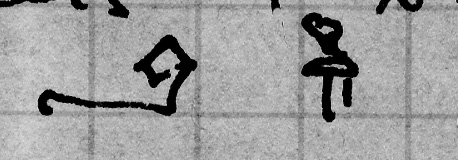 , viz.- 'front west'.
, viz.- 'front west'.
Pasted paper over the bad parts of the panels preparatory to
removal on Wednesday.
Press day about 25 visits. Mostly visitors coming out of
curiosity.
Mrs Newberry commenced upon the restoration as far as it is possible
of the remnants of the pall (209). So many much of the fabric
which before it was touched appeared though much darkened (a rich
chocolate brown) to be in fair preservation, but in the attempt to remove
it from its support it fell into a brown sooty powder.
Removed the fourth (N. section) section of the cornice of the IInd shrine
(237).
corner of the outer shrine, before the archaeologists and wives then
at Thebes.
Completed the dismantling of the IInd shrine - (237).
Exposed between the walls of this shrine and those
of the IIIrd shrine (238) objects on the north, south, &
west sides - these comprise two fans finely worked
and bows and arrows. See photos for exact positions.
The fans - gold handles finely worked and inlaid - are
I think unique as far as former discovery goes.
Their ostrich feathers are unfortunately much damaged
(?) from early insects.
On one of the tongues (present position N.W. end) of the N. panel
is the note 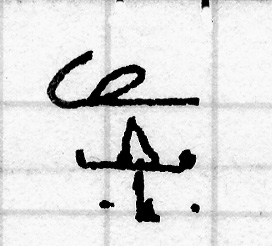 'back East' which corroborates
'back East' which corroborates
the contention that these shrines have been wrongly placed
in the sepulchral chamber.
Completely dismantled No. III shrine (238) today - leaving now
only the IVth to be taken to pieces. Both the IIIrd and fourth
shrines show signs of having been very carelessly put together,
many of the joints were not even properly closed. Also a number
of hammer marks where they endeavoured to hammer force the sections
together.
Removed the fans and bows, etc., lying between IInd (237) and IIIrd
(238) shrines.
Had conference with Maxwell (who came today especially),
Harkness & Lythgoe upon letter to be sent to the Dir. Gen. S. des. A.
In the afternoon lifted the lid of the fourth shrine (239).
Exposing the lid of the sarcophagus. Lythgoe & Harkness
were present.
With the good aid of Winlock, Lythgoe and Harkness dismantled
the fourth shrine (239) exposing the whole of the sarcophagus (240).
This proved to be of magnificent type and workmanship
though the actual lid of poorer work, was of granite, cracked
in two, and appears to be a makeshift.
The sarcophagus is of yellow crystalline sandstone, slightly tinted,
having the four goddesses Isis, Nephthys, Neith, and Selkit carved in high relief at the four corners
with their winged arms outstretched
protecting the sides and ends of the casket. The upper part has
the same entablature as the three outer shrines - namely: cornice,
of cavetto moulding, torus moulding, and frieze, the latter
bearing a legend. At the base is a dado of 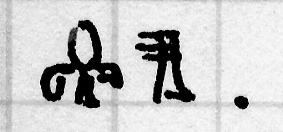 in relief, and on the four sides of the casket bands of text.
in relief, and on the four sides of the casket bands of text.
On the south side of the sarcophagus, placed nearly central,
was a large wooden painted emblem of 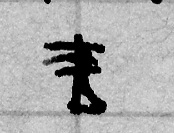 .
.
The lid, cracked of of granite, cracked in halves, takes the
form of the roof of a naos, thus: 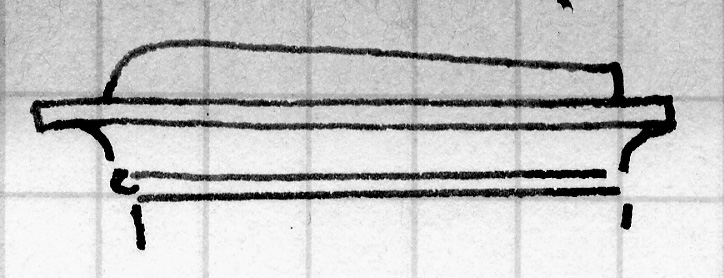 and is
and is
slightly let in the top of the cornice.
Removed the four parts of the IVth Shrine (239).
Shewed Bethell, Breasted (who came in the afternoon) and Newberry
the sarcophagus.
Took dimensions of the sarcophagus for necessary glass & tackle
to remove the lid. Many visitors came which gave one little
time.
Left for Cairo in the evening with view of seeing the
Min. of P.W.D. (Morkhos Bey Hanna).
As arranged with Tottenham the press were allowed to
visit the tomb during the morning.
Arrived Cairo. Saw Gardiner in the morning with whom
I had a long conversation with regard to attitude with this
new Ministry. He assuring me that their attitude
was to be friendly, and to be willing to let bygones
be bygones. He (Gardiner) seemed to have meddled
with the affair rather much, but with obviously good
intention.
As arranged saw Min. P.W.D. at 5 pm at the
P.W.D. On arrival I was told that the Min. was late
and that I should have to wait some twenty minutes.
While so doing I was called to go and see Tottenham
at his office, when Tottenham advised me to only
Minister - in fact he said it would be better if all former negotiations
could be forgotten & papers destroyed. Tottenham, then ha having
thus somewhat disarmed me, suddenly thrust upon me a document
which his ministry considered threw light upon the question of
division of the discovery. This document was no less than a
permit given to Lord C. to make an investigation in the Great Northern
Valley (8 Dec. 1918) where I thought I had made a possible
discovery. At first I did not recognise it, but when Tottenham pointed out
that it was signed by me & I began to read it carefully
the whole subject came clear to my memory & I at once
explained to him that it had nothing to with the Valley
of the Kings contract. We then proceeded to the office of the
Min. P.W.D.
There, with Tottenham, I met the new Minister, Morkhos Bey Hanna,
who appeared to be most gracious, and who almost immediately
complained that I had sent Gardiner to him with complaint against the S. des A.
This I explained was a mistake and that I believed Gardiner d
gone to him on a matter as representative of his colleagues with regard to their
feelings in the question of action on part of the S. des A., and that
it was nothing to do with me. The Min. then asked me if I was
'in accord' with the Service of Antiquities and I told him that
I was not 'in accord' with their methods of administration
but that personally other than that my feelings were quite different. He said
or rather asked me that I had any grievances would I write
him on the matter. I answered in the affirmative. The Min.
said that I thought possibly I had thought I might be legally within my rights.
I had made a great mistake in forming a contract with The Times
as it had certainly caused a nasty odour with the local press.
I agreed, but reminded the Min. that it was not altogether
my doing and that I was left with the legacy of The Times contract
was left me as a legacy which I had to protect, but I assured
the Min. that after April (1924), that contract would be at end & I
undertook it would not occur again. He then said that I was wrong
in going America so early this year - that I was in taking up this
scientific work a public servant. I pointed out to him that we were
not in exact agreement in this matter, and I immediately brought up
the question of the opening of the sarcophagus - I should add that Tottenham
told the Min. that the sub previous negotiations had been of an
acrimonious nature and that they better be left alone - the
Min. said let us not bring up the past. At this moment of the
conversation the Min. said to me that Mons. Lacau was waiting
& could he bring him in? I acquiesced, whereupon Lacau
came in with a dossier in his hand - Tottenham having already
brought a dossier with him. Lacau immediately referred to past
events and said that I was guilty of taking into the tomb a great
number of visitors - I answered 'let us stick to facts' and Tottenham
I haven't taken in one twentieth of the wha number the government
had invited, to which remark Tottenham agreed.
The Min. referred to the question of publicity to which Lacau laughed,
but at this point I reverted the conversation to the question
of opening the sarcophagus and said to the Min. I hoped H.E. would
be present at the ceremony. The Min. asked me whether they would
see the 'Corpse'? I replied that as far as we were able to judge
from previous evidence of the customs of the royal burials, no, but
probably only the outer coffin of a series of coffins containing
the royal mummy. The Min. was disappointed at this & said
he did not think it worth while coming. Then proposed that
he should send a delegate and that in the presence of Mons. Lacau,
and other representatives of the Service, I would, with my collaborators,
open the sarcophagus, and that if we were satisfied that the
results were sufficiently interesting we would advise H.E. to come
and view it. To this the Min. was in agreement. I also requested
that the press should not be allowed to see the tomb again on
Monday 11th as they would see nothing more than on the past press
view (Thursday 7th), but that I proposed opening the tomb to them on
Wednesday 13th to see results of our opening the sarcophagus on
Tuesday 12th. I also asked for three or four days from the 14th
for taking records, when no visitors would be allowed to enter the tomb
and that then after the Ministry, if they so wished, had viewed the
tomb, we should open it for a period of say about ten days
to the public - or rather authorised visitors holding permits from
the Ministry. The Minister was in agreement to this and
asked Lacau, Tottenham and myself to talk over the
arrangements, sign them, & present them to him. To this
weag (Lacau, Tottenham & self) agreed to do at Lacau's
house the following morning (8th) at 11am. This ended the interview.
(I should remark here that though the whole negotiations appeared
be quite amicable I felt inwardly that there was an atmosphere
of hostility; there was certainly an element of dictation in the interview.)
When leaving the Minister's office, just outside the door, Lacau
attacked me with regard to Gardiner's conversation with him - I answered
that I knew nothing about it & refused appealed to Tottenham against
any attacks of this kind.
At eleven am I met Tottenham and Lacau and
Lacau's house. There we drafted our mutual agreement
as procedure (1) the opening of the sarcophagus, (2) admittance
of press (3) time reserved for taking records, and (4) authorized
visitors to the tomb - the exact date of the latter question was
mutually agreed to be left open until we knew whether
the Minister & his colleagues would visit the tomb or not. A
(5th) clause was entered stating that with the exception of
the 13th inst. (press view) all visits will be suspended from
now until the tomb is opened to authorized visitors.
Tottenham mentioned the fact that some permitsdue for during
had been issued for the period in question and asked
what was to be done about it. I replied to that point that
we would do our best to overcome the difficulty.
We signed We (Lacau, Tottenham and self), signed
the draft agreement, and Tottenham was requested
to present the document to the Min. P.W.D. This ended our
negotiations.
I returned to Luxor that evening - having purchased
tackle any and glass for the coming preparations.
Lacau suggested to me that necessary scaffolding & preparations
would have to be installed in the tomb against damage of
the objects du during the visits.
We also agreed that the permits issued by the Ministry
should not exceed 750 as the time allotted to these visitsp
would not permit of more people - than 75 a day, this in
the interests of the public and in the upkeep of the
monument - Lacau suggested 200 a day - ie.
10 am to 1 pm & I represented to him that only a
certain number of 'peas could be passed through a tube
in a given time'.
Arrived Luxor - Gurna. Conferred with Mace who
lunched with me. I represented to Mace that though
I had gained the points we wanted for our scientific
side of the investigation and also those regarding press
and public visits, I, personally, was not impressed
with the general attitude of this new Gov., and stated
that 'oil and water would not mix'.
APrevious to my departure to Cairo, Engelbach had
written to me a letter suggesting a quite new rule
with regard to our light supply in the tomb. It was to
the extent if that if I require light in the afternoon
I must give him at least 2 hours notice before hand -
this so as to enable him to check his engineers accounts
and only for that reason. I annotated his letter asking
to waive the point as I could not always let him
know beforehand whether I might want the light in
the afternoon or not and if it was a question of accounts
I would check them for him - therefore would he please let
the matter rest at that.
I also reiterated this request to Engelbach in the tomb on
the same morning I wrote the note in reply to his.


